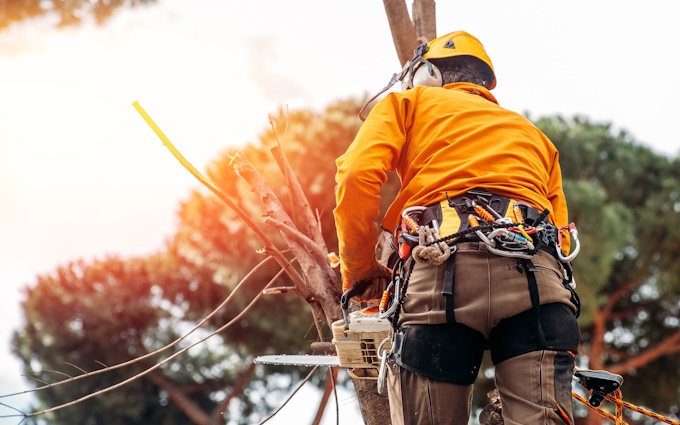Certified Arborists Near You Are Trained to Take On Tree Care – and That’s Good News For Your Landscape
Pruning trees might seem like a simple task, but it requires a deep understanding of tree biology, growth patterns, and the environment to support the tree’s health and maintain its structure.
Certified arborists and tree surgeons are professionally trained in the proper technique and best practices of pruning. These tactics help reduce the risk of sudden branch breakage and tree illnesses while keeping your outdoor environment looking beautiful.
You may be asking, “How do arborists near me learn how to professionally prune trees?”
What Is a Certified Arborist?
An arborist, also known as a tree surgeon, is a professional trained in the art and science of planting, caring for, and maintaining trees. Certified arborists are knowledgeable about the needs of trees and are equipped to provide proper care, which is essential for the health and safety of trees in both urban and rural settings.
To become a certified arborist, you need to complete training that covers a broad range of topics related to tree care. Here’s an overview of what it takes to become an arborist:
- Formal education: Many arborists start with a background in horticulture, forestry, or environmental science. These fields provide a solid foundation in plant biology, soil science, and ecosystem management, which are crucial for understanding tree care.
- Certification: Certification from recognized bodies, such as the International Society of Arboriculture (ISA) or the Tree Care Industry Association (TCIA), is an important step for an aspiring arborist. To become certified, arborists must pass an exam that tests their knowledge of tree biology, diagnosis, safety, pruning techniques, and more.
- Continuous education: Arborists are required to stay up to date with the latest tree care techniques and advancements through continuous education. This typically includes attending workshops, seminars, and courses on topics like tree planting and relocation best practices, advanced pruning techniques, and new equipment.
- On-the-job training: Practical experience is key to becoming a skilled arborist. Many certified arborists start their careers as groundskeepers or tree care workers, gaining hands-on experience in tree climbing, pruning, and equipment use under the supervision of experienced professionals.
Arborist-Approved Best Practices Of Pruning
Pruning is a vital part of tree maintenance that involves removing specific branches or stems to improve the tree’s health, structure, and appearance.
Proper pruning:
- Encourages healthy growth and flower or fruit production.
- Removes dead or diseased branches.
- Improves air circulation and sunlight penetration in the tree’s canopy.
- Reduces the risk of falling branches and structural issues.
- Shapes the tree in a visually appealing way.
Certified arborists follow a set of best practices when pruning trees for their own safety and to promote the long-term health of the tree. Their wealth of tree knowledge and advanced pruning technique makes them especially effective.
Arborists Understand Tree Biology
Arborists and tree surgeons must have a thorough understanding of tree biology to effectively prune, including how different species of trees grow and respond to pruning, as well as how to make cuts that promote healing and prevent disease.
Arborists Know the Right Time to Prune
Timing is crucial when it comes to pruning. Certified arborists in Kansas City know the best time of year to prune different species of trees to minimize stress, maximize healing, and even prevent the spread of tree diseases and pests.
Arborists Know Where to Cut
Arborists are trained to make precise cuts that promote the tree’s health and structure. This involves cutting just outside the branch collar, the area where a branch attaches to the trunk or another branch. This technique helps the tree heal faster and reduces the risk of disease.
Arborists Use Professional Pruning Tools
Certified arborists use a variety of specialized tools for pruning, including hand pruners, loppers, pruning saws, and pole pruners. The choice of tool depends on the size and location of the branch, as well as the reason for pruning.
Arborists Use the Correct Technique
There are several pruning techniques that arborists may use, depending on their goals. For example, thinning removes branches to improve air circulation and the amount of sunlight that enters the canopy. Crown raising and crown reduction are removing branches to either raise or lower the tree’s crown. Each of these requires a different pruning technique.
Arborists Know How to Maintain Tree Structure
Arborists focus on maintaining a tree’s natural shape and structure while pruning. This is especially important during the winter months, as trees hold more weight as ice and snow build up on their branches.
How to Find a Certified Arborist Near You For Pruning and Tree Care
Pruning trees is a delicate task that requires a deep understanding of tree biology, growth patterns, and the right tools and techniques. Certified arborists are highly trained professionals with the knowledge and skills to safely prune trees in a way that promotes their health and beauty.
With winter on the way, you may be asking, “How do I find a certified arborist near me?”
There are many qualified arborists in Kansas City to choose from. Type or say the phrase “arborist near me” into your favorite search engineto bring up local results for arborists in your area to choose from.

